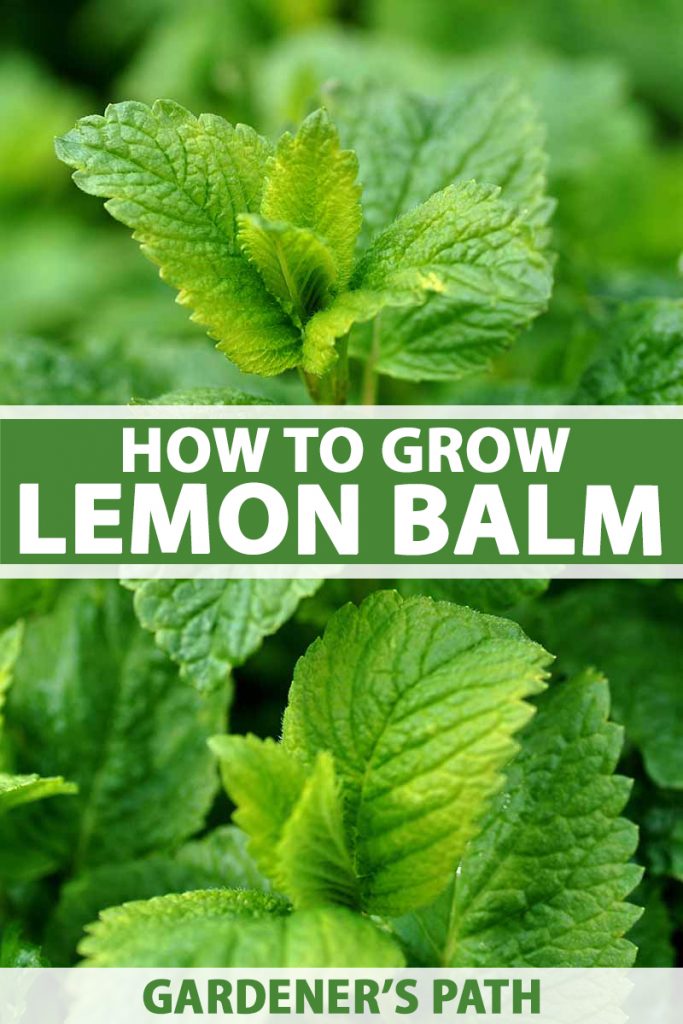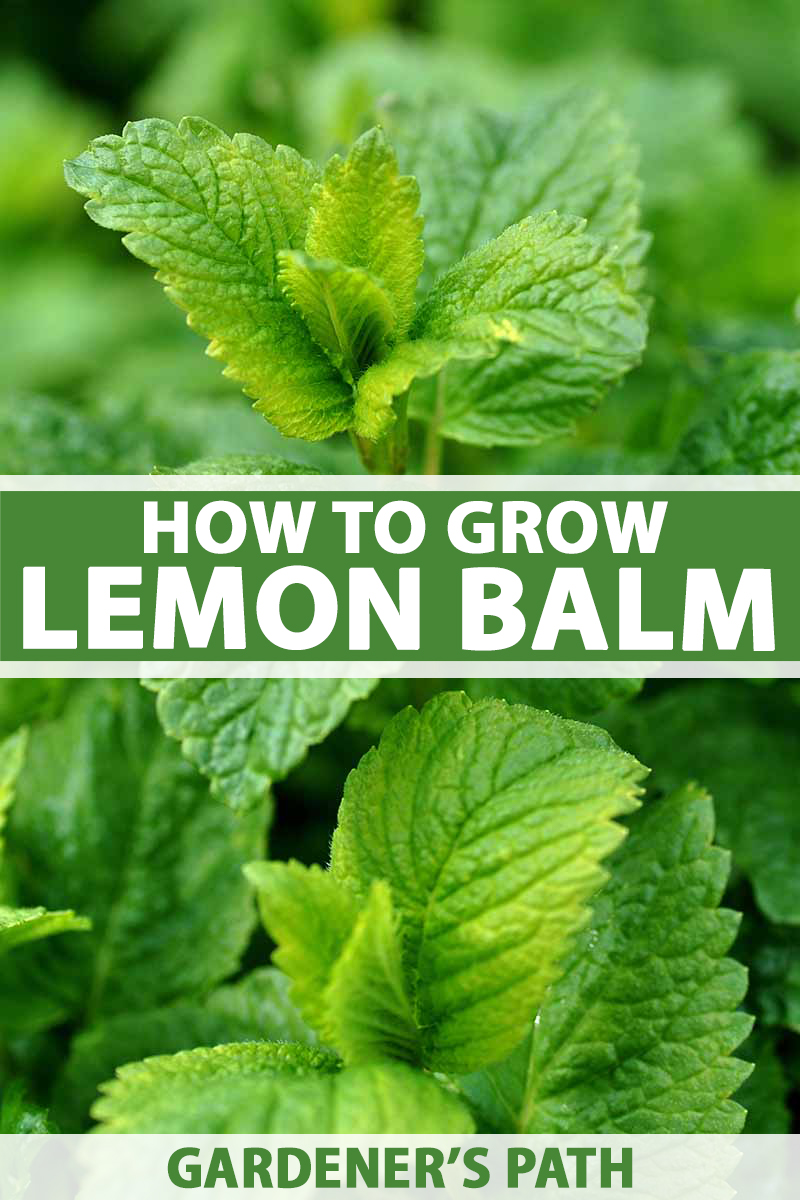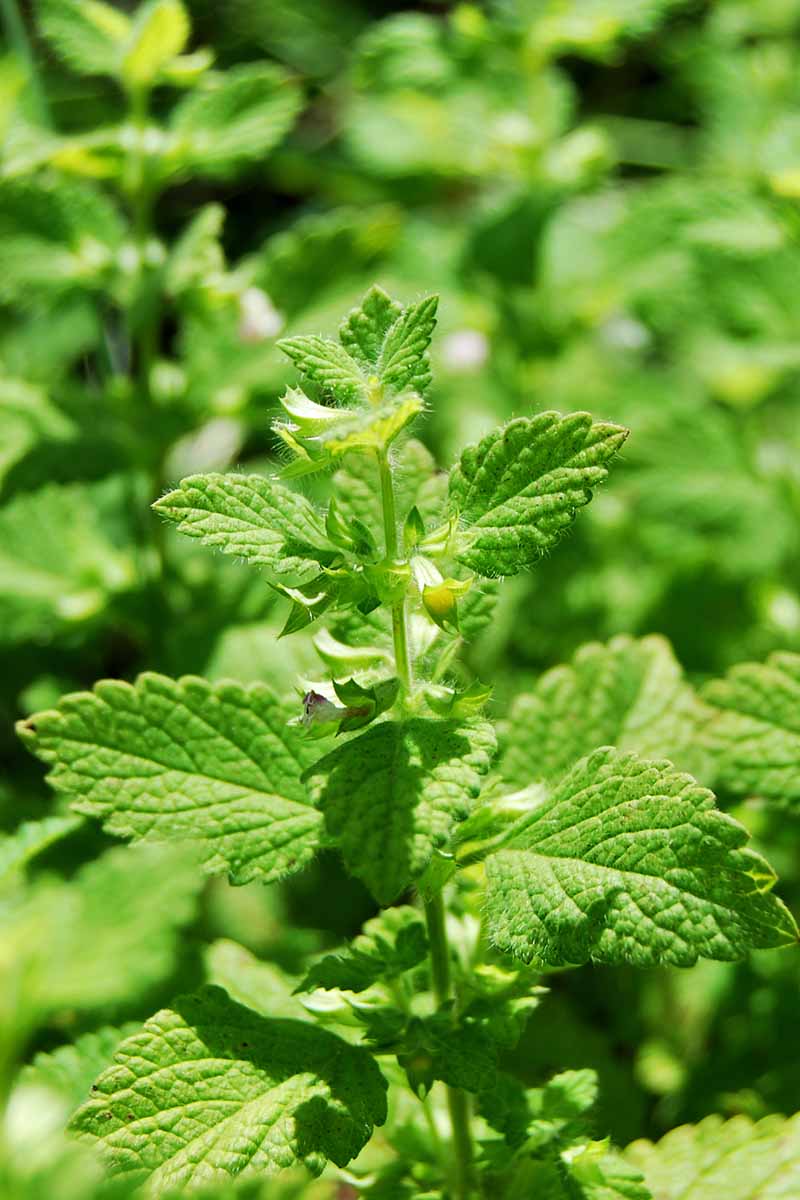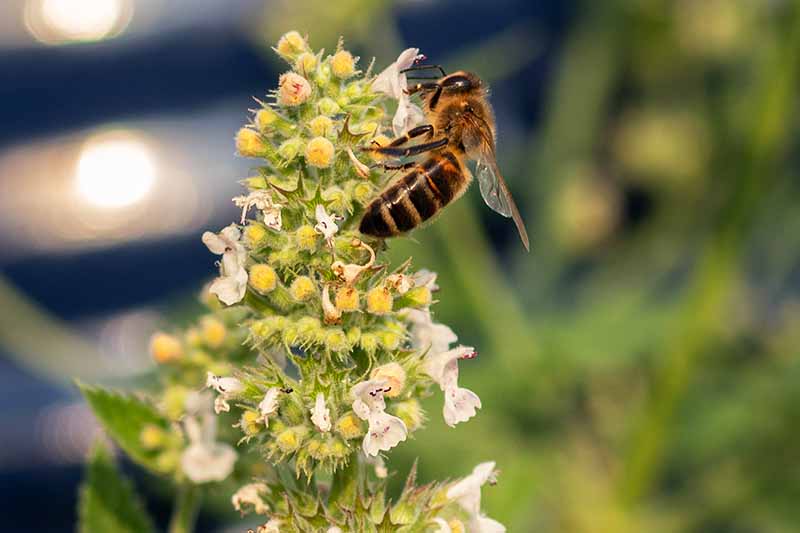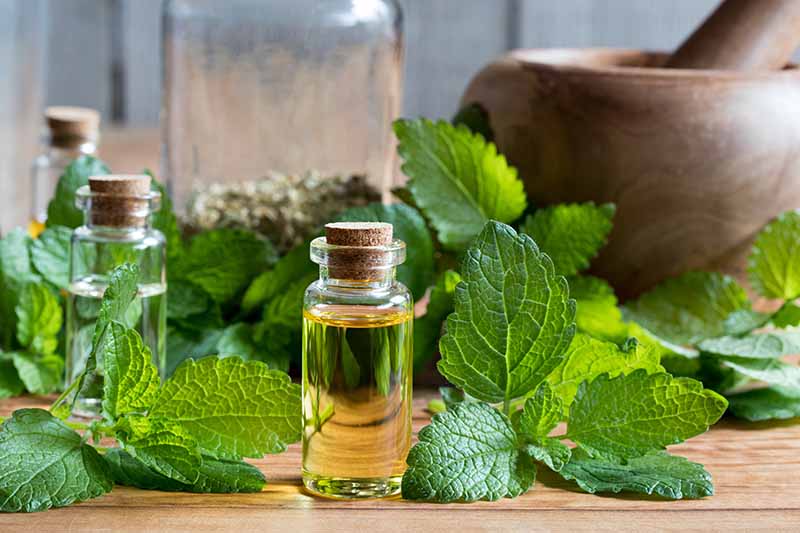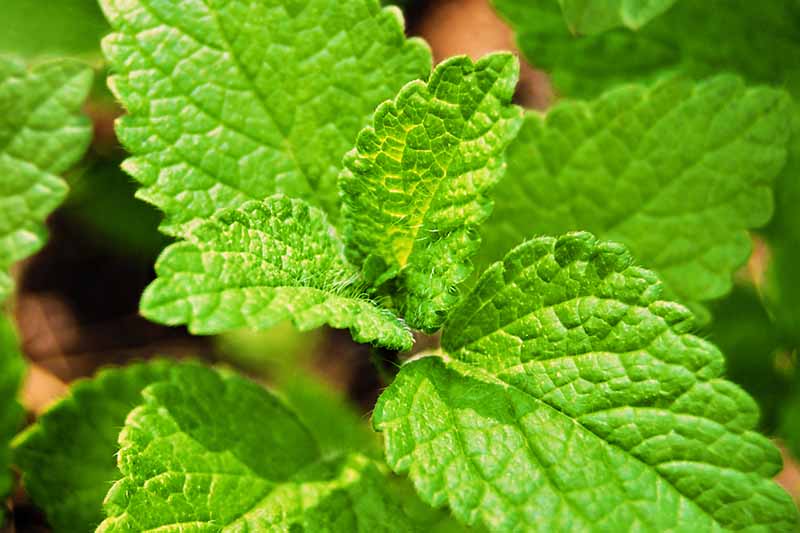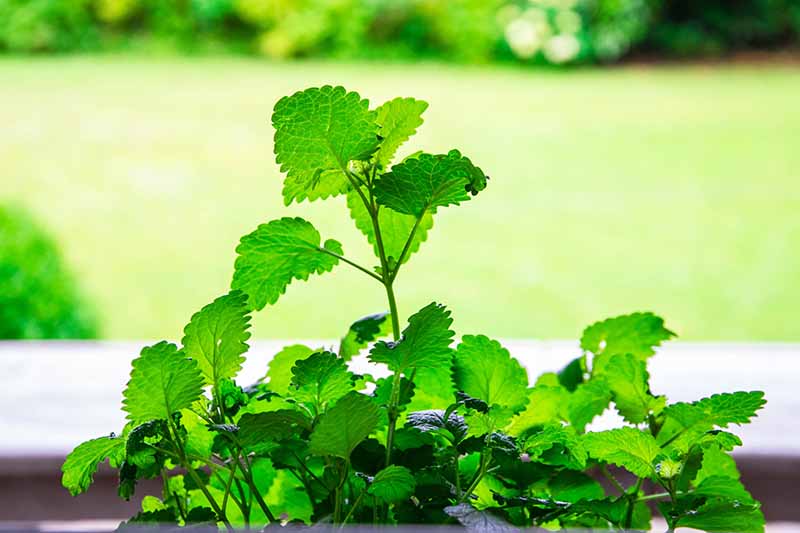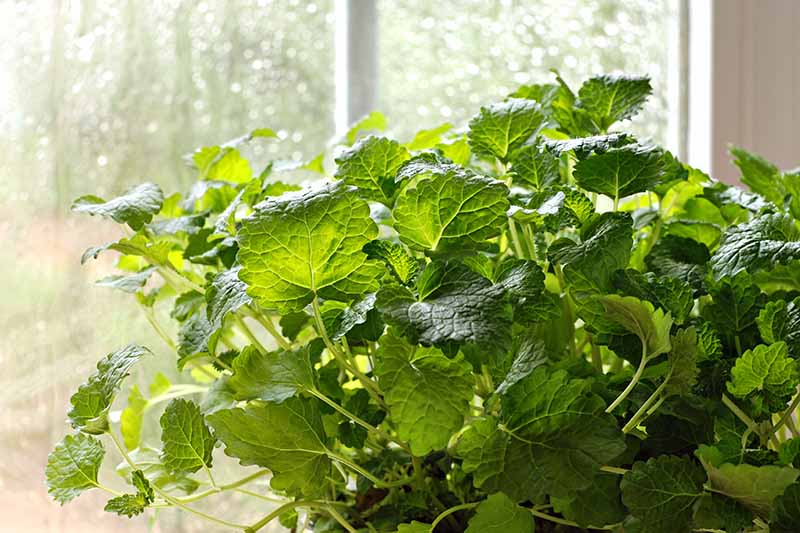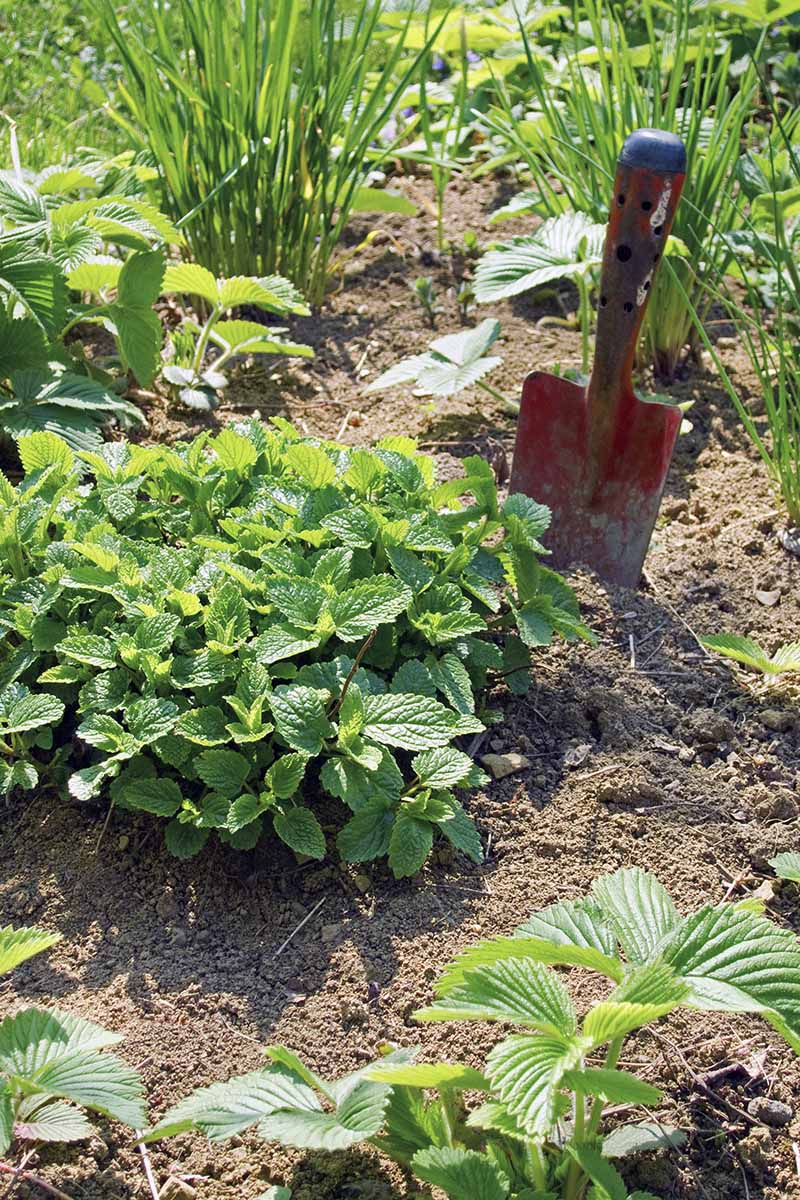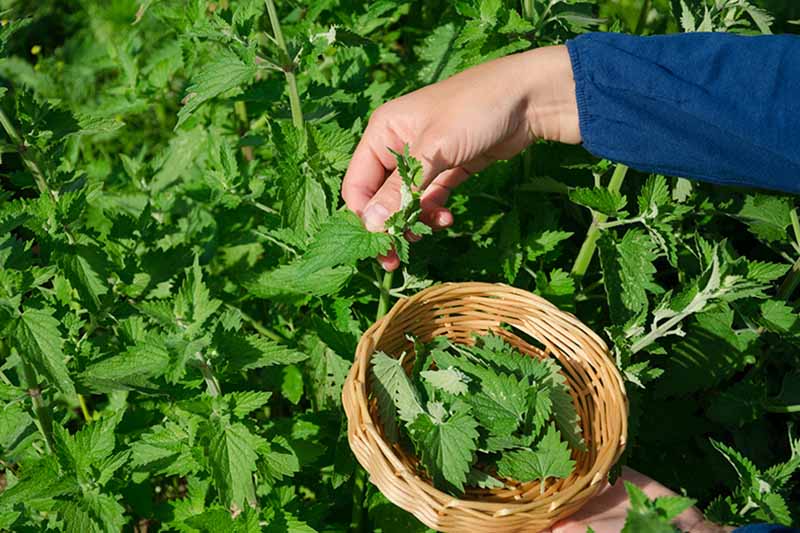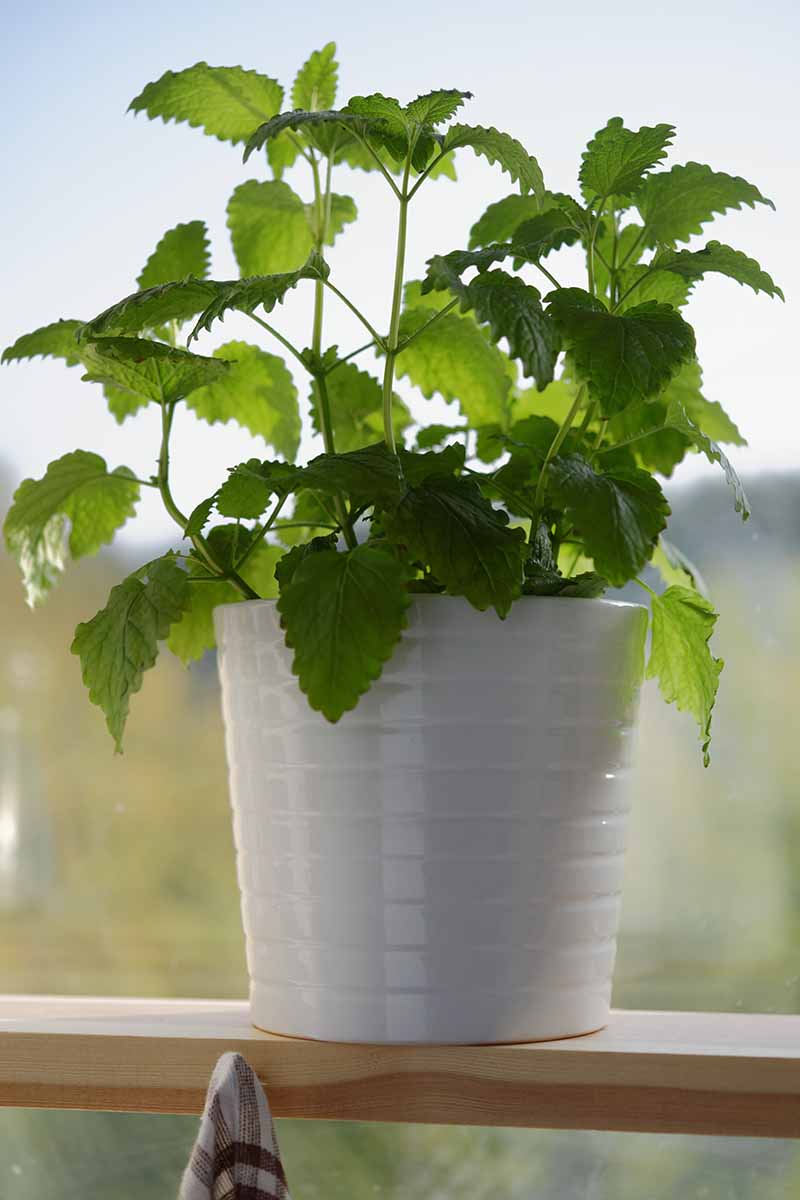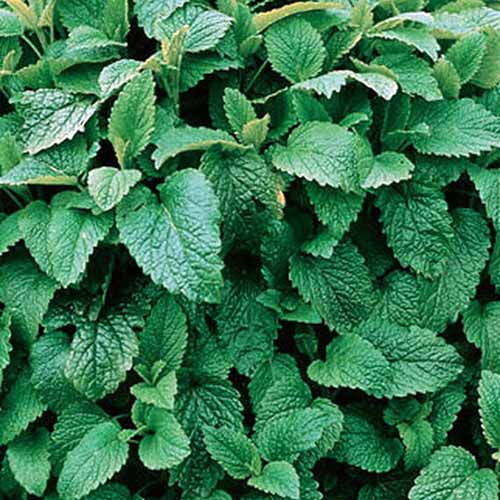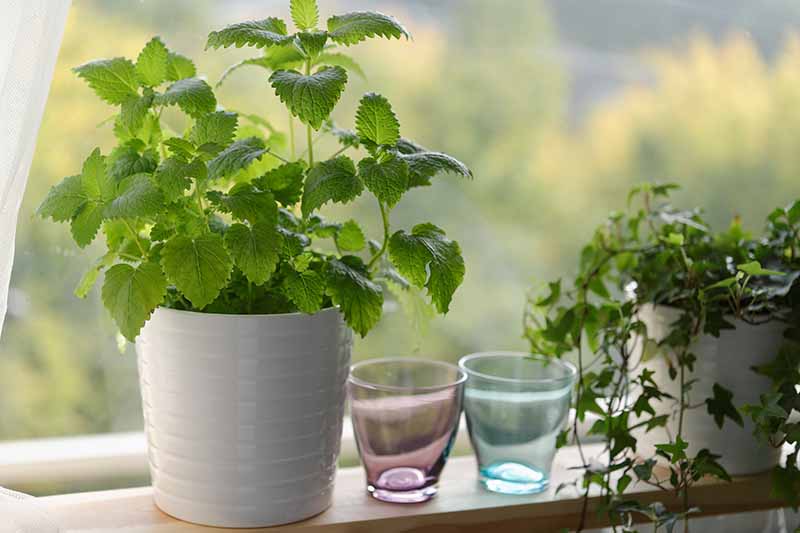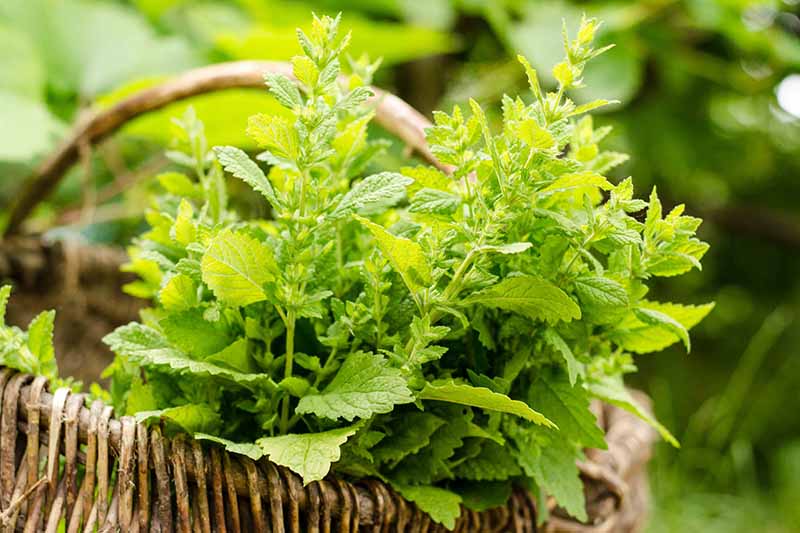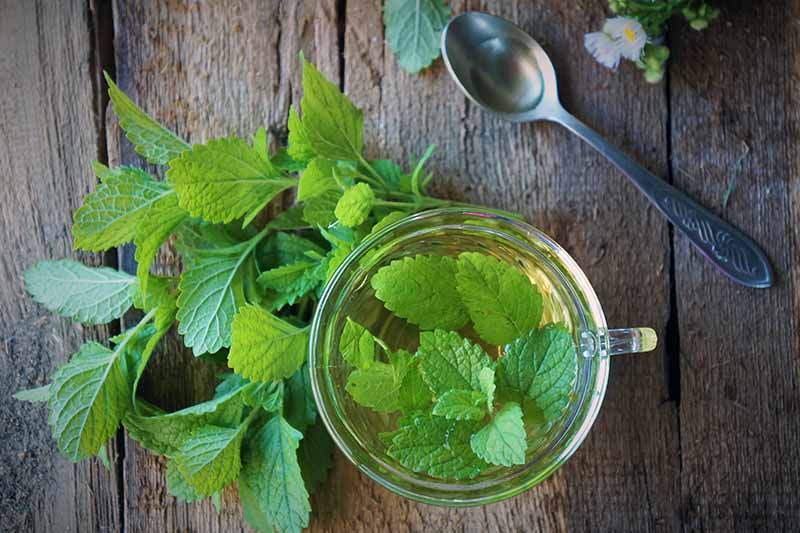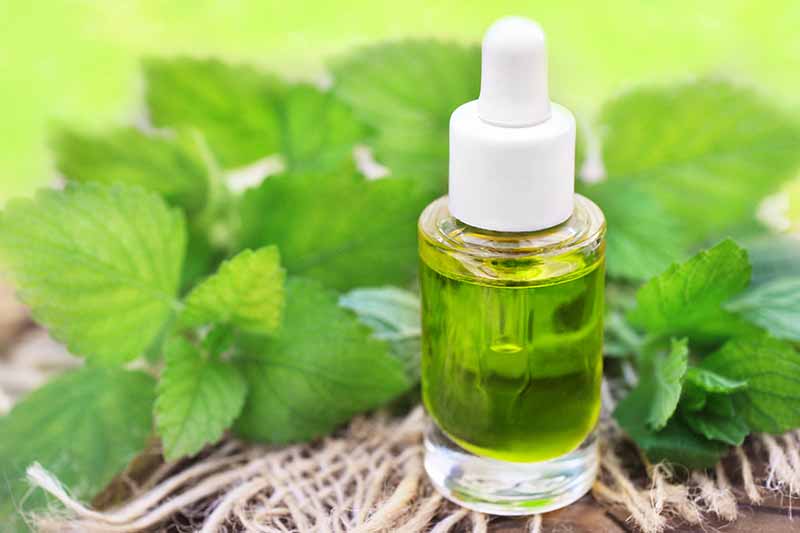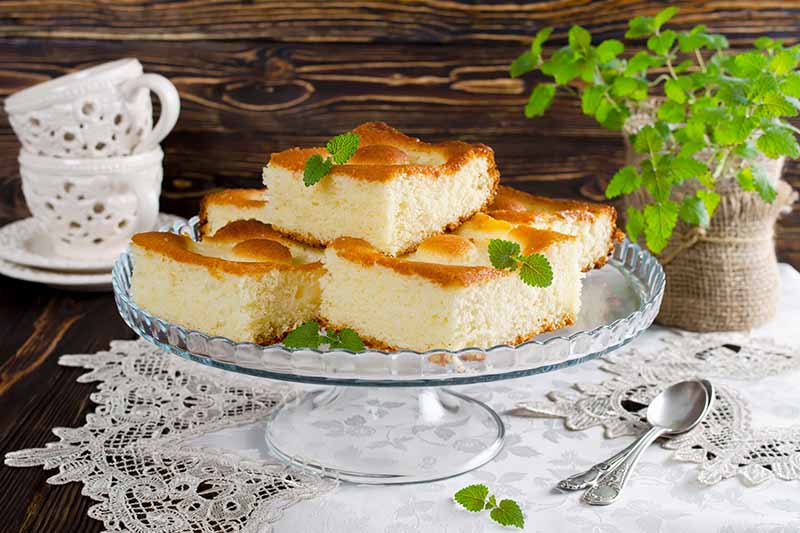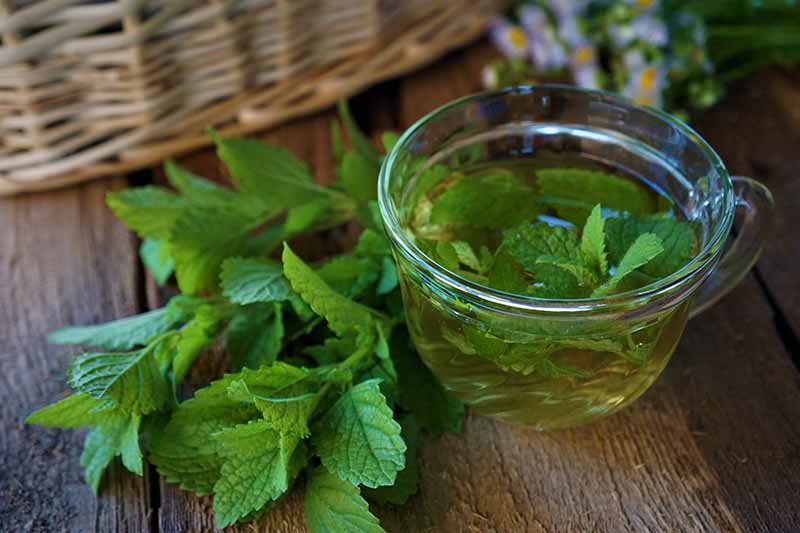We link to vendors to help you find relevant products. If you buy from one of our links, we may earn a commission.
What Is Lemon Balm?
Colloquially known by many names such as Melissa, sweet balm, honey plant, balm mint, garden balm, English balm, and heart’s delight, lemon balm is an herbaceous perennial member of the mint family.
It is a sprawling, bushy perennial herb with toothed, opposite leaves on square branching stems, tiny white flowers, and a subtle lemon fragrance and flavor. While it grows naturally in sandy areas, it has been cultivated in all manner of climates and conditions, in dry, damp, and disturbed areas, from the mountains to the sea. It has many wonderful uses in food and drink, medicine, cosmetics, and even crafts.
History and Folklore
Lemon balm is native to Southern Europe, though it has been naturalized around the world. Its use dates back to 300 BC, when it was used medicinally by Ancient Greeks and Romans. The first century Greek physician Dioscorides recorded use of this herb as a remedy for toothaches, scorpion stings, and dog bites, as well as to encourage menstruation and improve gout.
It was also often used to attract honeybees. This is likely where the genus name Melissa came from, derived from the Greek word “mélissa” or bee. A patch of Melissa would be planted near hives to encourage bees to return. The plant likely arrived in North America with the early colonists, who used it to make tea and potpourri, and attract bees to hives. It also served as a lemon substitute in jams and jellies. It was listed as one of the sixteen herbs documented in Thomas Jefferson’s garden book in 1794, listed under “Objects for the garden this year.” In plant lore, this herb is associated with health, longevity, and royalty, and has been thought to have powers of love, healing, and success. Placing a sachet under a pillow filled with lemon balm is said to bring about a relaxing and rejuvenating sleep.
Medicine
Lemon balm is a lively, uplifting herb that has long been taken as a tea to soothe, encourage focus, and reduce stress. It has a reputation for reducing anxiety, restlessness, and insomnia, and has historically been used to treat indigestion, gas, and bloating.
According to David Hoffman in his book “Medical Herbalism: The Science Principles and Practices of Herbal Medicine,” It is also high in antioxidants, including luteolin, glucoside, and rhamnazin, and has some antiviral properties. The oil is sometimes utilized as an antiviral against herpes. Safe for consumption by children and adults, it makes a lovely tea or tincture, is wonderful in cooking, and adds a delightful fragrance to oils, salves, and lotions.
Propagation
Lemon balm is a cinch to grow, and can be propagated in a variety of ways.
From Seed
Direct sow seed in early spring by broadcasting seeds on the soil surface or cover only lightly with soil, as this plant needs light to germinate. Add compost if you wish, though this herb does not require any special soil conditions.
Seeds should sprout in 5-9 days with soil temperatures ranging from 65-70°F. You can also choose to start seedlings in flats indoors or in a greenhouse in early spring. Sprinkle seeds in trays on top of potting soil, and keep them moist until they sprout.
From Cuttings
Cuttings can be taken in the spring or fall. To propagate from cuttings, simply cut a few inches from the soft tips of an established plant. In the spring, cuttings should be taken a few inches below the tips of new growth. In the fall, they should instead come from stems that are closer to the base of the crown that have not flowered.
Remove two thirds of the leaves from the base of each stem, and pinch off the tips to prevent wilting. Next, dip the stems in rooting hormone or honey, and place in a sterile planting mix combined with equal parts coarse sand to help retain moisture. Water cuttings immediately and keep them out of direct sunlight. The plants should root in about 3 to 4 weeks. You can also speed up the rooting process by placing pots over a heating pad set to 70-75°F. It is a good idea to harden off cuttings in a bright and windy area for about a week before replanting outdoors.
From Seedlings/Transplanting
Harden off seedlings planted in trays and started indoors by bringing them outside for a few hours each day. Move them outside about 4 weeks before the last frost date.
They can be planted as soon as the soil is ready to be worked in spring. Space plants 1 to 2 feet apart and water immediately after transplanting.
Division
This perennial can also be easily propagated by division. Just dig up clumps of an established plant when it’s dormant in the early spring or fall, divide into smaller pieces, and replant either in pots or directly in the ground. You can read more about dividing perennials here.
How to Grow
Melissa can be grown in full sun or partial shade. While adaptable to almost any soil and sun conditions, some people find that it can lose color if exposed to too much sun, and that some shade can actually improve the flavor. An optimal growing environment for this herb includes moist soil, good drainage, and protection from hot weather. It is always a good idea to incorporate some compost into the soil prior to planting. Additionally, because it has such a robust and sprawling root system, you can plant it on a hillside to prevent erosion! A vigorous grower, once established this herb rarely needs fertilizing or much in the way of special care.
Like other mints, it has a tendency to sprawl. But unlike its creeping relatives, lemon balm spreads by seed rather than via rhizomes. While it does self seed quite easily, it won’t take over the garden in quite the same way. That said, it is a good idea to plant it somewhere that you are fine with it sticking around for a while with an expanded footprint! Or you can easily grow it in containers if you prefer. See more on this below. If you want to prevent it from spreading, simply harvest the tops prior to flowering so it doesn’t have an opportunity to go to seed. Mulching will also help to prevent seed spread.
You can thin plants throughout the season, which will keep growth in check and help to improve air circulation, especially in hot and humid weather. To prune, just snap off a stem from the base and use the fresh leaves immediately, or dry them for later use. You can thin out about a third of the plant at once, taking care to remove any leaves that are damaged or brown around the edges due to heat, cold, low humidity, or high wind. This plant responds well to cutting. If a plant has become overgrown, looks stressed, or is showing signs of disease, you can just cut the whole thing down to the base and wait for it to re-grow. It will likely grow back with thicker, more lush foliage the next time around.
Container Growing
Lemon balm is a great option for container gardening, and it pairs well with summer annuals such as dill or basil. To grow lemon balm in a container, plant seeds or transplants in a pot that is at least eight inches deep and 15 to 18-inches wide. Place the pot in a location that receives at least 5 hours of direct sunlight a day.
Though not as flavorful when grown indoors, it can also be kept inside with 14-16 hours of artificial light provided per day, if necessary. Container plants may need to be divided in the fall to avoid becoming root bound.
Growing Tips
While adaptable to most soil conditions, planting in moist, well draining soil with some protection from hot weather will result in healthier plants.
Mulch to improve drainage and prevent seeds from spreading.
Remember to thin throughout the season to keep growth in check and improve air circulation. Use the leave you’ve pruned to make fresh lemon balm tea!
Cultivars to Select
There are a number of cultivars available to choose from.
The Standard
For the classic variety, try M. officinalis, available from True Leaf Market. Its lovely lemony aroma and flavor is wonderful fresh or dried in food, drinks, cosmetics, and medicine.
M. officinalis Live plants and seeds are also available from Burpee.
Aurea
This variegated lemon balm cultivar has a beautiful dark green leaf with bright yellow variegation in spring, which fades in summer.
It is an edible ornamental with a mild flavor.
Citronella
This variety grows to 10-12 inches in height, and smells strongly of citronella. It has a high oil content and is mildew resistant.
Compacta
If you are short on space and worried about sprawl, this may be the option for you. This sterile cultivar tops out at about 6 inches tall and 12 inches wide, and does not flower or produce seed. It has dark green leaves and a moderate flavor.
Managing Pests and Disease
Lemon balm is not commonly affected by pests or disease. In fact, this herb can actually repel some pests from the garden. It contains a chemical compound called citronellal, which is repellent to many bugs, and this is what gives it its delightful lemony scent. There are just a few pests and diseases to watch out for:
Aphids and Spider Mites
These pesky little bugs have been known to infest plants, especially when grown indoors or in a greenhouse.
Washing plants off with a hard stream from a hose or in the sink can help to remove any pests. An insecticidal soap may be used if pests are present in large numbers.
Powdery Mildew
This common fungal disease can leave a whitish powdery look on the leaves. This is generally more of an issue in hot and humid climates with cool nights.
Septoria Leaf Spot
This fungus can cause dark brown or black spots on leaves, and is prevalent in warm temperatures with high humidity. Remove and dispose of infected leaves when they appear. If the infection becomes serious, try spritzing off plants with a spray of one gallon of water, one tablespoon baking soda, 1/2 teaspoon dish soap, and one tablespoon horticultural oil. Both of these diseases can be prevented by providing good air circulation with regular harvesting or pruning.
Harvesting
Lemon balm can be harvested regularly throughout the season, though the leaves are the most flavorful when they are young and fresh.
You can harvest individual leaves or sprigs as needed throughout the season by cutting several inches of new growth and removing the leaves from the stems. Keep leaves on stems for easy drying. Alternatively, harvest large amounts at once by cutting back the entire plant to almost ground level. This can be done a few times throughout the season. However you choose to harvest, this herb will provide an abundance! Since it grows so readily, it is a pretty difficult plant to over harvest.
Preserving: Fresh Is Best!
This herb is definitely at its prime when it’s fresh. It tends to lose some of its flavor over time, though I have found that with proper preservation techniques, it is possible to enjoy lemon balm throughout the year. It can be dried on trays or by hanging it in bunches in a dark place with good air circulation. You can also put your harvest in a dehydrator for 12-18 hours on a low setting.
The key is to dry it quickly, otherwise excess moisture on the leaves will cause it to turn brown and lose flavor. If you are planning to dry this herb, it is a good idea to harvest on a dry day so the leaves are less moist to begin with. Once dried, strip the leaves from the stems and store in an airtight glass container with a lid in a dark, dry location such as a cupboard. Get more tips on drying and storing herbs here. Lemon balm can also be frozen. Chop fresh leaves, mix them with cooking oil or water, and freeze in ice cube trays for later use. You can learn more about freezing fresh herbs here.
An Herb With Many Uses
Lemon balm is one of my favorite plants to have around because I use it in so many different ways! It can be used in oils and salves, creams, lip balms, hair rinses, steams, and baths. it is an amazing herb to incorporate in homemade cosmetic products.
Want to have a relaxing spa experience at home? Try filling a mesh bag with a combination of fresh or dried lemon balm, lavender, rose, calendula, and chamomile, and adding it to your next bath! You can also make a floral water called a hydrosol that can be sprayed around the house to add a natural lemony perfume to the air. Hydrosols are easy to make and they capture a small amount of the plant’s essential oils.
Here’s how to make a hydrosol at home:
- Pour a few inches of water and 3-4 handfuls of the fresh herb into a large pot, and place another smaller bowl in the middle, ensuring that its rim is above the surface of the water. Put on the pot lid upside down and fill it with ice cubes to encourage condensation.
- Bring to a light boil, then lower the heat and simmer until the smaller bowl has filled with a few ounces of water. The condensation that has gathered in the smaller bowl should now have a delightful lemony scent.
- Transfer this liquid to a small spray bottle for use around the home. Keep it refrigerated, to extend its usefulness. It can last up to two years if properly stored. This plant is also great for use in crafts! Dried leaves can be used in potpourri and pillows, and fresh or dried cuttings can be used as fragrant fillers for flower arrangements and bouquets. Try making a lemon balm wreath by wrapping flowering stems around a wire ring base. Commercially, the oil and extract are often used to flavor beverages, liqueurs, candies, and cosmetic products.
Recipes and Cooking Ideas
In the kitchen, lemon balm can be added to just about anything that might taste good with a hint of lemon. Throw it in appetizers, desserts, main courses, salads, sandwiches, soups, or stews. Add it to dressing, vinegar, sauces, and jams.
The flowers are also edible and can be candied or used to garnish fruit salads, beverages, or desserts. My favorite way to use lemon balm is in iced tea. I absolutely love it mixed with fresh raspberry leaf and nettle. It is also delicious blended with black or green tea. Just throw a few handfuls of fresh or dried leaves in with your favorite tea blend and steep for 5 to 15 minutes.
We provide directions on making lemon balm tea here. I also often use it as an ingredient in pesto. When I head out to my garden to pick fresh basil, I make a quick stop by the lemon balm patch as well, and throw some leaves in the food processor for added zest! You might also like this recipe on our sister site, Foodal, for making herbal shrubs. Use lemon balm to create a sweet and citrusy drinking vinegar that can be added to cocktails, sodas, or other beverages.
Quick Reference Growing Guide
An Underrated Ally
Lemon balm may not be the most talked about herb on the block, but it certainly shouldn’t be overlooked.
After all, what is there to lose? Just throw out a few seeds, sit back, and watch it grow. Its energy and liveliness will be sure to brighten up your garden, kitchen, and home! Do you have experience growing and using lemon balm? Tell us your stories in the comments below! Want to expand your herb garden? Then you’ll need these growing guides:
Grow Common Sage, A Mediterranean Culinary Staple Love It or Hate It, Cilantro is Easy to Grow How to Grow Horehound How to Grow and Use Epazote Herb
© Ask the Experts, LLC. ALL RIGHTS RESERVED. See our TOS for more details. Uncredited photos: Shutterstock.
